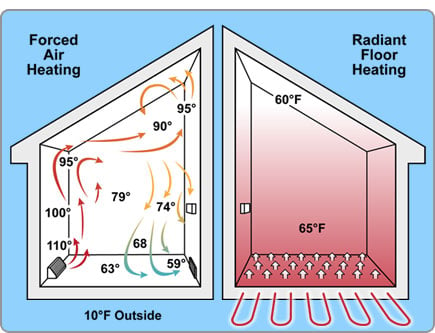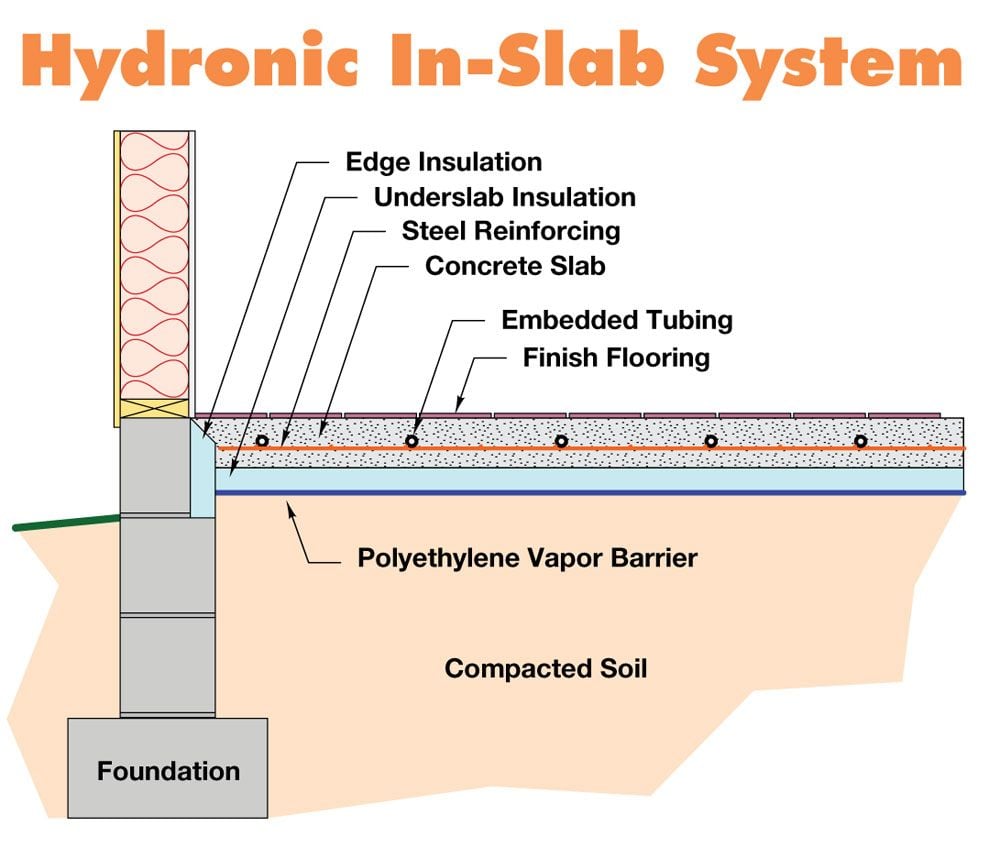On radiant floor heating: costs, tips, and comparisons
To keep comfortable in winter, you walk around your home in socks and slippers. You dream of a heated floor and the warmth it brings. If this describes you, then you might consider having radiant floor heating installed. But what is radiant flooring? And how does it work?
Radiant floor heating – the basics
Remember the old radiators? Accordion shaped, searing hot, and bulky – sitting just below the window, and taking up much of the wall? Well, imagine one of those spread out and hidden underneath your floor. Say hello to radiant floor heating.
Radiant flooring typically comes in two forms. Either insulated electric wires (typically mats) embedded into concrete or a tiled floor. Or you might also see cross-linked polyethylene (PEX) tubing installed beneath your floor in the joist cavities or in concrete (great for basements).
As the mats or tubes heat up, your room is heated evenly because the mats cover the floor. It’s more efficient than a vent that heats in specific locations. If in concrete, the heat lasts longer because it warms the concrete mass which, once heated, will hold the heat better than air.
Radiant floor heating is also much cleaner. A home furnace uses cold air returns , heats the air, and pushes it out through the vents. It’s why we have furnace filters, to capture any dust or allergens. With radiant floor heating, you don’t have to worry about the air cooling then warming again, nor do you have to worry about allergens being blown around your space. Plus, there’s the added benefit that radiant flooring is invisible and quiet.
Hydronic floor heating costs
Because radiant flooring heats up faster and can run at lower temperatures, the operating costs can be significantly lower than traditional heating systems, such as a furnace. The temperature throughout the room is regulated, as opposed to a furnace that will constantly be turning on and off; constantly trying to maintain a certain temperature. Also, because the air isn’t being blown around, there is less heat lost to doors and windows.
Of course, costs will depend on the size of the space you’re heating, cost of electricity or natural gas, how well your home is insulated, and what type of thermostat you use. A smart thermostat can schedule the heat to turn on just before you get home, and can be just warm enough during the day to keep pipes from freezing. Also, because you’ll be maintaining a consistent heat, the monthly cost of heating to you will be reduced from what it would be if you were running a traditional furnace.
While an electric system is much cheaper to install, the costs to run are much higher than a natural gas boiler system.
TIP: Some hydro companies offer incentives for installing radiant floors. Speak to your electricity provider to see if they offer any breaks.
Are you looking for the best home insurance rate?
In less than 5 minutes, you can compare multiple home insurance quotes from Canada's top providers for free. Comparing rates online could save you hundreds of dollars.
Installing a radiant floor heating system
To have radiant flooring added to your home, labour costs are where you’ll see the majority of the costs. but it’ll vary on a few factors.
It really comes down to access and what’s there already. For instance, if you want to put down radiant on your basement floor. Your basement floor will first have to be ripped up to get to the bare concrete. Once the concrete is exposed, electric mats can be put down with ease and a thin self-levelling concrete layer, like agilia screed, can be poured on top. If you want to use PEX, you’ll need a fastening system to hold the piping down. There are mats you can loop them into, or you may have to lay down a wood structure/
If you want temperature controlled rooms – where one room is hotter than another, you’ll need a distribution system which will drive up the cost.
A basic system, installed, will cost about $6-$8 per square foot, but with so many variables it’s hard to give an exact number.
TIP: If you’re in the process of renovating your home, or are looking to do so in the near future, talk to your contractor about installing a radiant flooring system. This will be the cheapest time to have a system installed.
Electric vs. Hydronic radiant heat
There are two types of radiant flooring systems on the market, hydronic and electric.
Hydronic Systems
This system works by having water heated by a tankless heater or a boiler, which then travels through flexible plastic tubing inside your floor. Installation of this tubing happens in various ways. You can attach it to your subfloor and build on top, or embed the tubes into concrete.
Electric Systems
This system involves electric cables, typically pre-attached to mats, being installed above your subfloor in thin-set mortar. Electric systems are typically less expensive to install, but can be more expensive to operate given the cost of electricity.
Ask yourself if you are looking to install your radiant system throughout your entire house, or in individual rooms like your bathroom and kitchen. This will have an impact on the type you choose to install. Hydronic systems are generally better for the whole home, while electric are a great way to supplement existing heating. Remember, hydronic systems can be powered by natural gas which is far cheaper to run than electric.
TIP:If using an electric system, try running it at a higher temperature at night in order to “charge” the floor. This could help reduce your electricity use during the day.
Flooring options for radiant floor heating
When you decide on the finished floor, consider how it handles heat. Having a carpet might not be the best option, as you will end up insulating the effects of the system.
Ceramic tile and stone floors are great as heat is distributes itself evenly. This type of flooring also conducts heat and because of the material it won’t contract or expand which could be disastrous to other materials such as hardwood.
Laminate or engineered flooring should be your go to if you want that wood look. They won’t expand or contract like hardwood, but still have the aesthetic you seek.
If you’re renting out your basement, you can save on space. You don’t need a bulky furnace or bulkheads for the ducting anymore. Ensure your tenant has renters insurance in case a pipe does spring a leak.
Impact of radiant floor heating on home insurance
When looking to install a radiant system, it’s important to speak to your home insurance provider about what impact it will have on your costs. If they believe radiant flooring to increase your costs, never hesitate to shop around for home insurance quotes to see if you’re getting the best value.
Some things to consider: If you’re using a hydronic system, there’s the potential that the system could leak or break down, causing damage to your home. If you use an electric system as your primary system and there’s a power outage, it could lead to frozen and burst pipes. Burst pipes can also cause damage to the system itself. The age of the system will also be something your homeowner insurance provider will want to know. The older the system, the more chances there are of it breaking down, and therefore the greater risk.
TIP:The coils of your radiant system should last longer than your lifetime, but the mechanical parts of the system can age and deteriorate with use. Be sure to run yearly maintenance on your system. Don’t ever run it at too high a temperature as it could damage the system.
It’s important to inform your insurance provider of whatever type of heating system you have in your home. The type of system you have will impact their risk assessment, and affect your policy. Speak to your insurance provider about how a radiant flooring system could affect your insurance policy. It’s also a great time to compare rates now that your houses value and its risks has changed.
The Bottom Line
Comfort in your home is invaluable. A radiant floor heating system gives you clean, efficient heating and cooling. If you’re undergoing a renovation, it’s a great time to ask about replacing the old furnace, duct runs, bulkheads and replace them all with piping that is inconspicuous, quiet, and can last much longer. Having a professional install it and maintain it and your comfort will last for years without any risks to your house insurance.
ALSO READ

